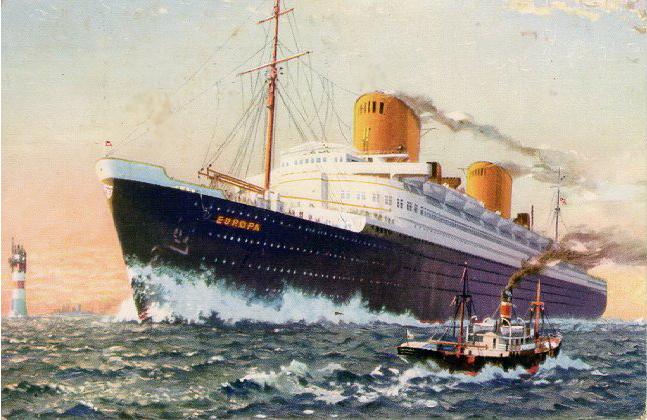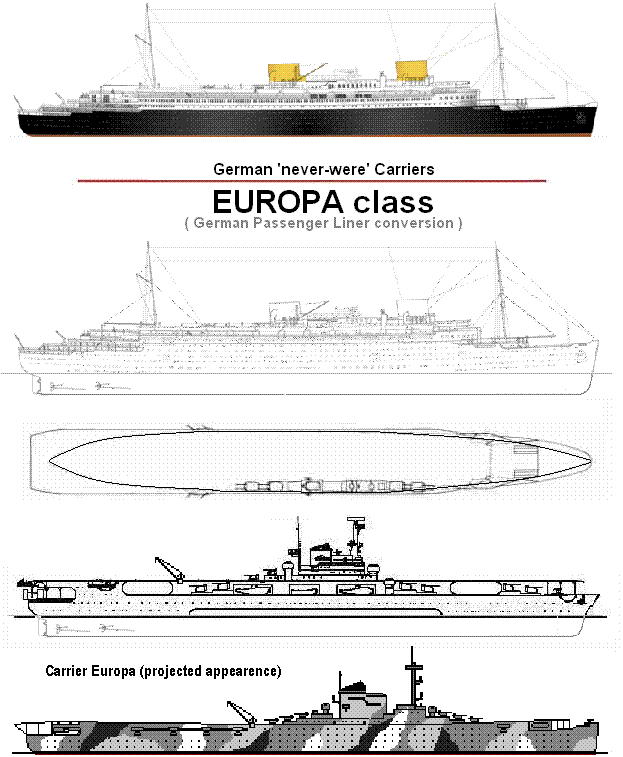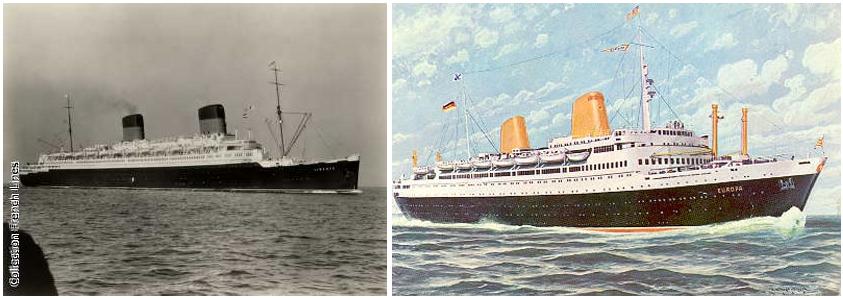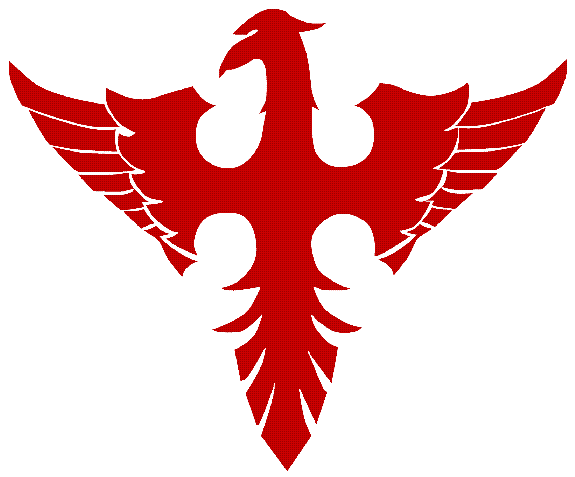From the end of the 1940 war year on, German naval leadership concerned itself-at least partially as a result of the successful British carrier-plane attack on the Italian fleet at Tarento with considerations as to how to remedy the lack of aircraft carriers most quickly. 
Kreigsmarine Aircraft Carriers - Europa Class ==========================================================================

A series of five cruisers and merchant ships were planned for conversion starting 5/1942 as an effort to provide a practical naval aviation force. None of the ships was ever completed as a carrier, and most conversions were never started. All were cancelled late in 1942 or early in 1943, when the carrier programs were cancelled. These were not sisterships, but are listed together for convenience. These vessels are commonly identified by their original names; new names had not been assigned prior to cancellation of the conversions.
Generally similar to GRAF ZEPPELIN. The conversion would have involved removal of existing superstructure and construction of a new flight deck, hangar, large island, and a heavy defensive battery. Details varied among the ships.
Subjects under discussion concerned not only the reconstruction of existing large warships, but also the adaptation of merchant ships, insofar as they seemed suitable in terms of size and speed. Included in these considerations were the battleships SCHARNHORST and GNEISENAU, as well as the heavy cruisers LUTZOW (a re-named pocket battleship formerly known as the "Deutschland") and ADMIRAL SCHEER on the one hand, and the passenger ships EUROPA and POTSDAM of the North German Lloyd line on the other.
The passenger ships were the only ones that met the basic requirements: the EUROPA was the largest, since the loss of the BREMEN to fire, weighing nearly 50,000 tons, and had a suitable top speed of 27 knots, while the POTSDAM, of only about 18,000 tons and a speed of 21 knots, were somewhat less well-suited though still usable. In addition, the rebuilding of the heavy cruiser SEYDLITZ, about 90% finished, seemed feasible, as opposed to converting the battleships of the SCHARNHORST class and the heavy cruisers LUTZOW and ADMIRAL SCHEER, which were then dropped from these considerations.
The creation of aircraft carriers was one of the main points in the Commander of the Navy's report to Hitler at the latter's headquarters on May 13, 1942. Thereupon Hitler decided that the EUROPA and POTSDAM should be rebuilt into auxiliary carriers. In a further report taking place on August 26, 1942 a further possibility was suggested: this involved the French cruiser DE GRASSE, lying on the slipway in Lorient, of which the rebuilding into an aircraft carrier seemed feasible.
The rebuilding plans for these ships were begun at once. In the process it was learned that the task had obviously been strongly underestimated and the difficulties that would necessarily arise in the construction of these ships, intended as they were for fully different purposes, had gone unrecognized. It was chiefly their form and weight stability and their inner division that were insufficient. It was believed that these problems could be mastered by applying a thick "armor plate" of heavy cement and building on side bulges, but this could not be achieved in a really satisfactory way and, in addition, brought about a limitation of their speed, which was not that great to begin with. The EUROPA-now designated "Auxiliary Aircraft Carrier I"-was to be rebuilt by Blohm & Voss in Hamburg-her builders-but this did not transpire: as early as November 25, 1942 the work of planning was halted and the rebuilding was cancelled even before the work had begun. The reason for this was the lack of stability even with the bulges built on, the problem of rigidity caused by the lowering of the hangar deck into the main formation deck, which could not be done any other way, and finally the expected very high fuel consumption when the ship was in use again.
The rebuilding of the other passenger ships was to be entrusted to the naval shipyards at the Howaldt Works of Hamburg , but with the cancellation of the rebuilding of the EUROPA, the contract for the POTSDAM was transferred to Blohm & Voss in November of 1942. With them too, problems of a very similar kind arose, especially in terms of stability, which were addressed with the same means-building on bulges and applying heavy concrete "armor plate."
According to a decision made on the same day, this was to be set up as a training aircraft carrier. The work actually began that December: in Kiel they began to remove the passenger cabins. In the midst of this work, it all came to an abrupt end on the basis of the aforementioned "Fuehrer’s Command."
The work of planning for the conversion of the uncompleted French heavy cruiser DE GRASSE, which began in April of 1942 under the designation "Auxiliary Aircraft Carrier II", led to this project being given up, as it was shown to be too expensive in terms of work and materials, was under ever· increasing danger of air attack, and finally, second thoughts about what from the German standpoint was an unsatisfactorily divided power system could not be allayed. At the beginning of February 1943 the planning work was halted.
After the spring of 1943 the navy had no possibility of any realizable construction of aircraft carriers.

Hilfsflugzeugträger Project I - German Liner Europa
The passenger ship Europa was one of the more famous ships, of the North German Lloyd line, traveling on the North Atlantic route.
Built by Blohm & Voss. Laid down 1927, launched 16 August 1928, damaged by fire 26 March 1929, completed 19 March 1930.
The defeat of Germany in 1918 by the Allied forces left the German merchant marine non-existent. All of Germany's ocean liners were given to the victorious nations. With no ships to call their own, the North German Lloyd Line (NDL) quickly set upon building new ships to compete with the British and French. In 1929, roughly ten years after the armistice, the passenger liners Bremen, and her sister Europa, were launched. These German "greyhounds" were the most technologically advanced ships in the world at that time. First off the two were welded together instead of being riveted. Also the two were the first ships to employ the new 'bulbous' bow scheme to reduce drag. The ships both captured the Blue Riband for fastest crossing of the Atlantic. The world was stunned that the Germans so quickly built these express steamers, AND captured the speed record from the British Mauretania. These two ships alone made the entire British merchant marine from the Olympic to the Aquatania obsolete.
Competition from other nations soon emerged, though with the launch of the Italian Line's Rex in 1931, the French Line's Normandie in 1932, and Cunard's Queen Mary in 1935. In the mid-30's came Hitler's rise to power. Many passengers of the Europa could find many copies of 'Mien Kampf' in the ship's store. Actress Marlene Deitrich upon seeing the "Hitlerazation" of these liners, vowed never again to sail on a German ship. Tensions began to mount between the European nations the ships carried that tension to the see. It was customary that when two liners pass each other they blow their whistles three times. When Normandie and Europa passed on time, they did not salute each other, a sign of things to come. With war looming on the horizon the all liners were on full alert because should war be declared then the ships if armed could open fire on one another. In one such occasion the Queen Mary was on her return trip to England when word came that the Bremen was ahead, and Europa was behind. Fearing that they were armed, the Queen Mary beat her own west-to-east crossing record.
In the summer of 1939 the Normandie was being followed by the Bremen the captain of the Normandie ordered all windows blacked out and proceeded on a zig-zag course. The Bremen found herself trapped in New York when war is declared on September 1, 1939. With British cruisers waiting just outside American waters to destroy her, the Bremen secretly escaped and arrived at Bremerhaven.
Europa was at Bremerhaven when World War II began, and was considered, along with her sister ship for the planned invasion of England (which never happened, of course). Hitler used the Europa along with other liners in a secretive rearmament program that was strictly denied by the Versailles Treaty.
After the start of World War II, the Europa was first used as a barrack ship and in 1940 as a troop transport. Being the largest passenger ship in Germany, the Europa was also selected in the 1942 auxiliary carrier program to undergo conversion into an aircraft carrier, but because of the lack of stability of the hull and the high fuel consumption use.
A series of five cruisers and merchant ships were planned for conversion starting 5/1942 as an effort to provide a practical naval aviation force. None of the ships was ever completed as a carrier, and most conversions were never started. All were cancelled late in 1942 or early in 1943, when the carrier programs were cancelled. These were not sisterships, but are listed together for convenience. These vessels are commonly identified by their original names; new names had not been assigned prior to cancellation of all the conversions. Generally similar to the Graf Zeppelin design. The conversion involved removal of existing superstructure and construction of a new flight deck, hangar, large island, and a heavy defensive battery. Details varied among the ships.
Europa would have been the largest of the converted carriers, but the design suffered stability problems. Conversion abandoned 25 November 1942.
Near the war's end, Europa was captured in 1945 in Bremerhaven by the United States and then used as a Navy transport to ferry troops home after the war ended..
With the end of World War II, once again the European nations found their merchant marine non-existent. Again, German ships were awarded to the victorious nations. The French were awarded the Europa, she was given to France's Compagnie Générale Transatlantique (French Line) as partial reparation for loss of the Normandie. She was renamed Liberté, but only six months later, she broke her moorings in Le Havre during a storm, drifted into the wreck of the Paris, and sank. This caused her post-war conversion to be delayed while she was raised and remodeled (to reflect French taste). In August of 1950 she again entered service and had her maiden voyage as the Liberté. Paired with the Ile de France, Liberté carried the French Line through the 1950's. Liberté was retired in 1958, and docked in Le Harve alongside the new French liner France. With her future unknown some attempts were made to have her become a hotel in Seattle, Washington during the 1962 World's Fair. That didn't work out, and Liberté was towed to Italy for scrapping.
=================================================================================
NB: The above text has been collected / excerpted / edited / mangled / tangled / re-compiled / etc ... from the following online sources :
KM - German Auxiliary Fleet Carrier Program - http://www.hazegray.org
KM - German Auxiliary Fleet Carrier Program - h863.org
KM - Carrier Europa - www.german-navy.de
KM - SS Europa - /lch4/europa/
KM - Ocean Liner Europa - www.oceanliners.org
KM - Passenger Liner Europa - wikipedia


